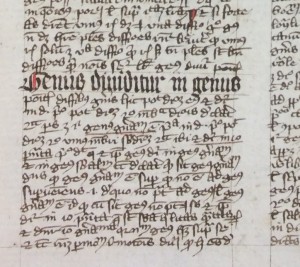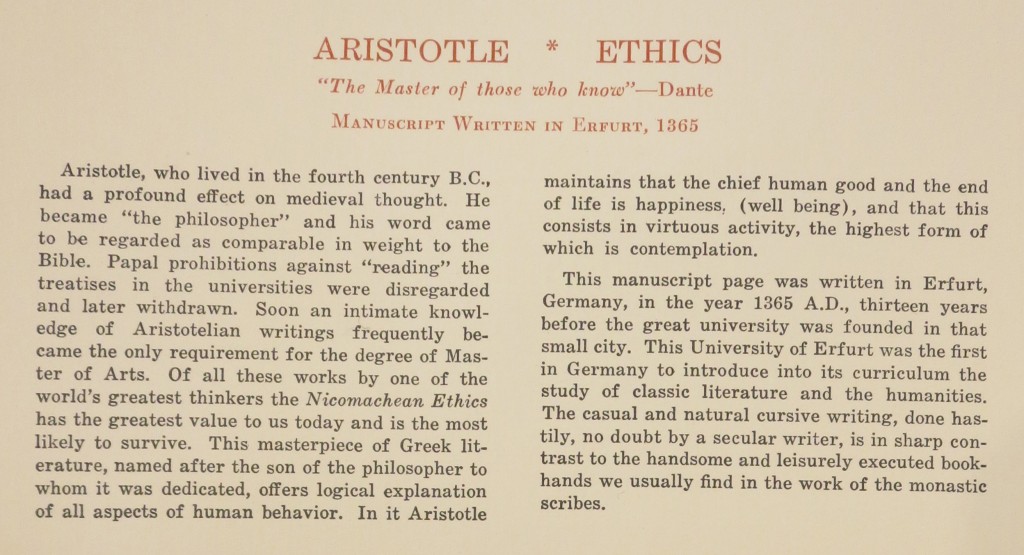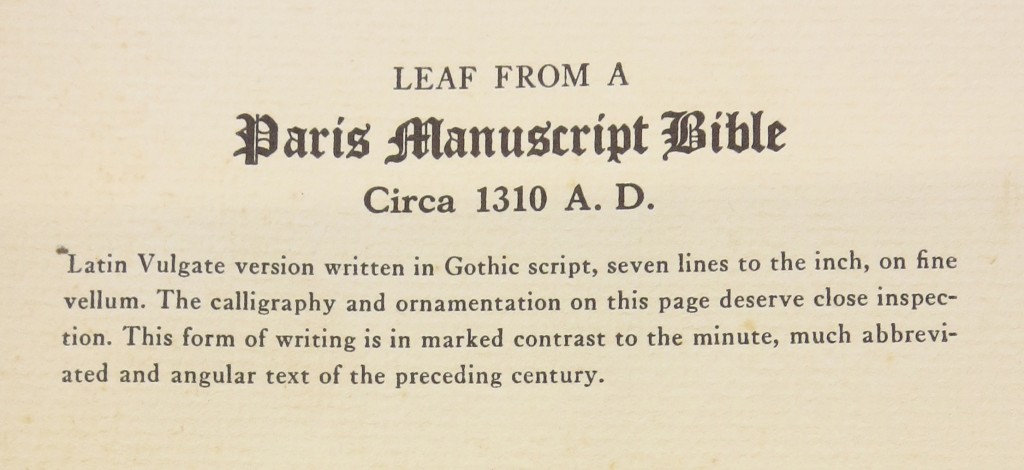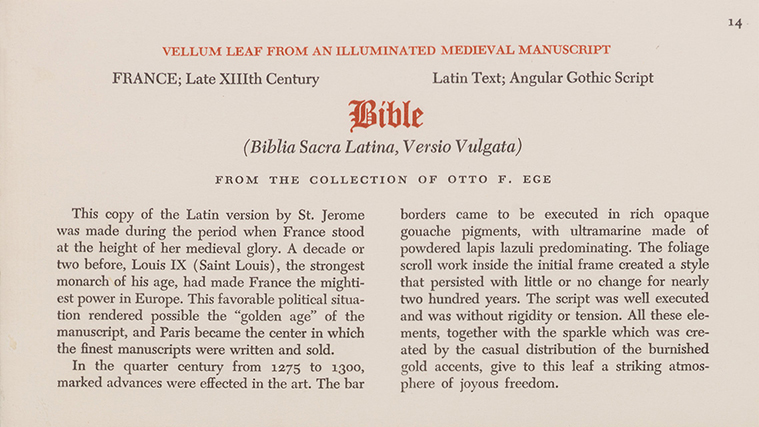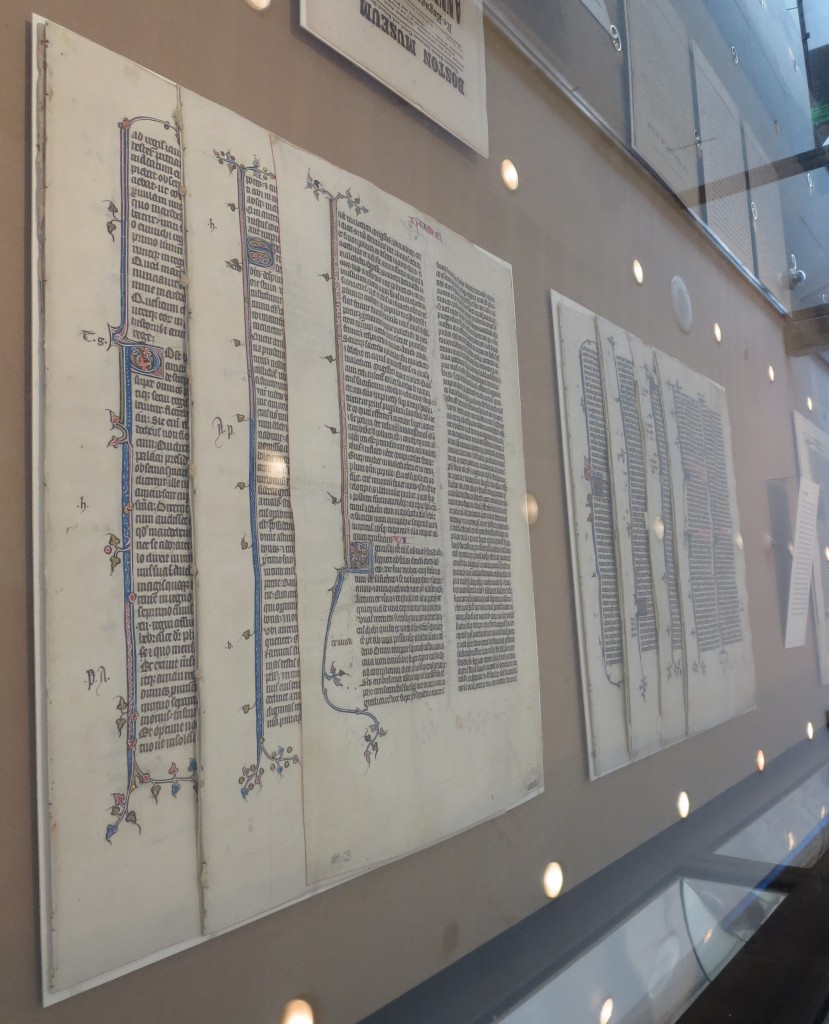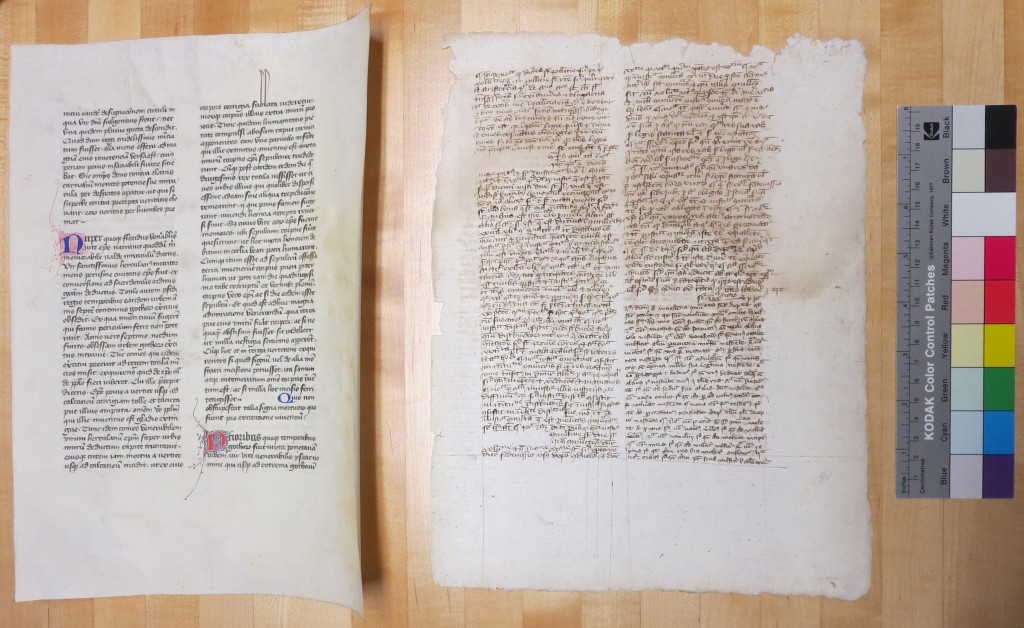Updates for Some “Otto Ege Manuscripts”
March 23, 2018 in Manuscript Studies, Photographic Exhibition, Reports
More is More

“A Long Shot”. New Acquisitions Exhibition at the Beinecke Rare Book and Manuscript Library in November 2016: View of Some Parts of “Otto Ege Manuscript 14”.
Continuing our series on Manuscript Studies, Mildred Budny (see Her Page) adds new evidence to her earlier reports of some leaves from medieval manuscripts dispersed by Otto F. Ege (1888–1951).
Revisions are now in order. As we continue to look at, and for, evidence of the dispersed materials, the old and new evidence shows more. While giving some answers, the observations also raise new questions.
Time now for more Updates for Some “Otto Ege Manuscripts”.
[Published on 15 December 2017, with updates]
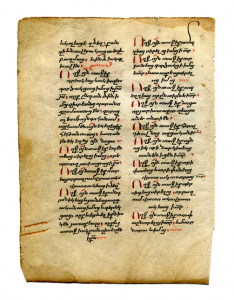
Armenian New Testament fragment in bologir script, folio II verso in Romans. Private collection. Reproduced by permission.
Recent research trips and conferences have revealed more evidence for the dispersed “Otto Ege Manuscripts” considered in our earlier blogposts. According to Ege’s own labels, citing Scott Gwara’s Handlist Numbers, and linking to the blogposts (where you may find further references), the manuscripts are Ege Manuscripts 8, 14, 41, 51, and 61.
Also, there emerges a surprising and mysterious connection with a dismembered Old Armenian New Testament manuscript considered before in its own right in a blogpost and downloadable Booklet — but now requiring a reconsideration, which may cast fuller light upon associations between Otto Ege and Dawson’s Bookshop. The Plot Thickens.
The Selected Manuscripts, the Portfolios,
Their Versions or Editions,
and Other Forms of Distribution
Distributed in 3 different Ege Portfolios (as well as otherwise), the 5 Ege manuscripts are these:
I. Distributed in Ege’s Portfolios of Famous Books, issued in 2 versions,
respectively Eight Centuries (1240 A.D. – 1923 A.D.) and Nine Centuries (1122 A.D. – 1923 A.D.):
- Aristotle’s Nichomachean Ethics “Written in Erfurt, 1365” = Ege Manuscript 51
More Leaves from “Otto Ege Manuscript 51”
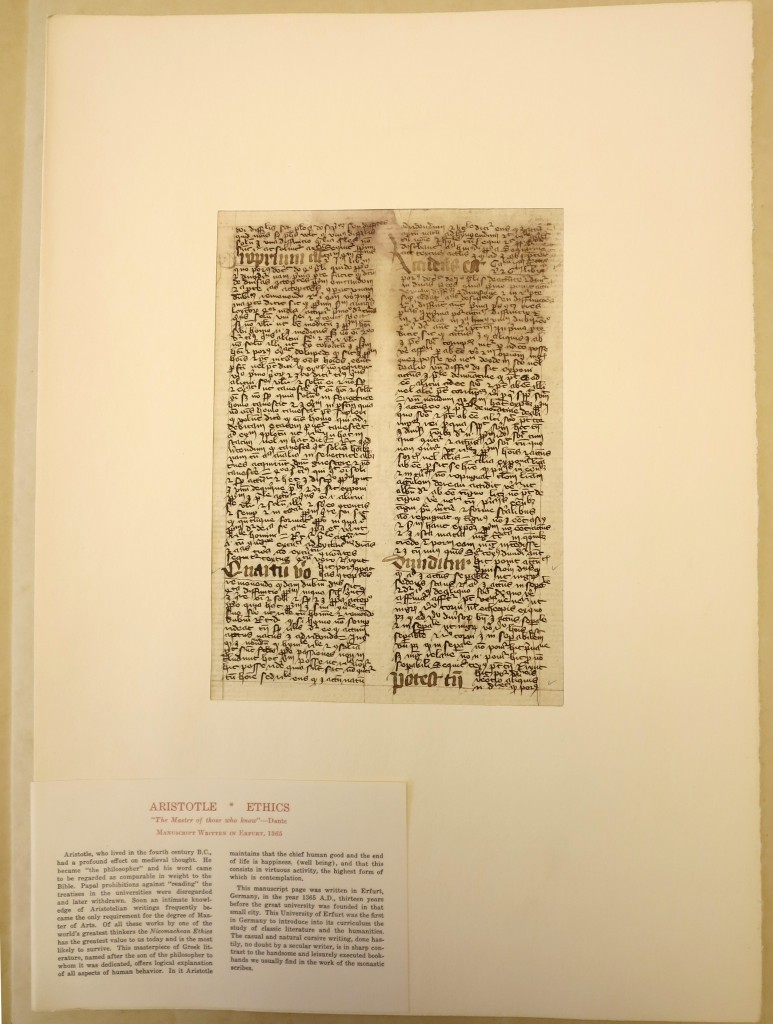
Otto Ege Collection, Beinecke Rare Book and Manuscript Library, Yale University. Ege Manuscript 51, Leaf 6 viewed through mat
II. Distributed (but not invariably) in Ege’s Portfolios of Famous Bibles, issued in 2 versions, both in Nine Centuries (1240 A.D. – 1923 A.D.), in Editions respectively of 200 Copies with 37 Leaves or of 100 Copies with 60 Leaves:
- “Leaf from a Paris Manuscript Bible Circa 1310 A. D.” = Ege Manuscript 61
A New Leaf from “Otto Ege Manuscript 61” -
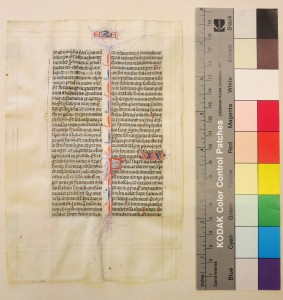
University of Pennsylvania Libraries. Leaf from ‘Ege Manuscript 61’, Original Verso. Photograph by Mildred Budny
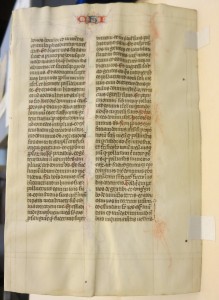
University of Pennsylvania Libraries. Leaf from ‘Otto Ege Manuscript 61’, Original Recto. Photograph by Mildred Budny.
III. Distributed in the Portfolio of Fifty Original Leaves from Western Medieval Manuscripts in Six Centuries:
- “Dialogues of Gregory the Great” [and Other Texts] = Ege Manuscript 41
A New Leaf from “Otto Ege Manuscript 41”
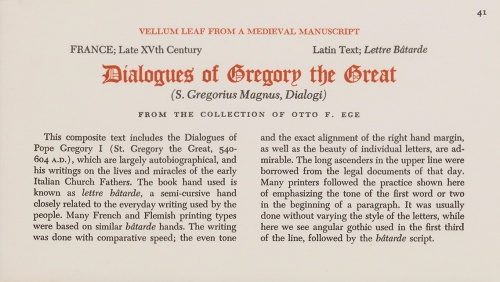
From the Collection of the Public Library of Cincinnati and Hamilton County. Reproduced by permission.
- “Bible (Biblia Sacra Latina, Versio Vulgata), France; Late XIIIth Century” = Ege Manuscript 14
A New Leaf from “Otto Ege Manuscript 14” - “Gradual” = Ege Manuscript 8
A New Leaf from “Otto Ege Manuscript 8”
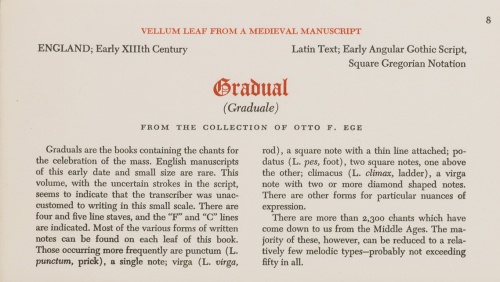
Otto Ege’s Printed Caption for Portfolio Leaf 8. From the Collection of The Public Library of Cincinnati and Hamilton County. Reproduced by permission
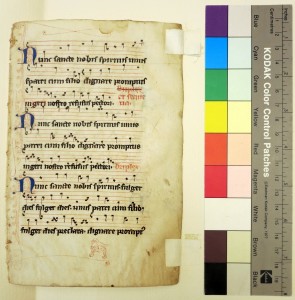
Beinecke Rare Book and Manuscript Library, Otto Ege Collection, Family Album, Specimen Leaf from ‘Ege Manuscript 8’, Recto.
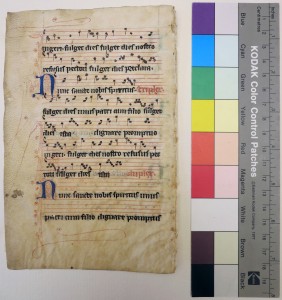
Beinecke Rare Book and Manuscript Library, Otto Ege Collection, Family Album, Specimen Leaf from ‘Ege Manuscript 8’, Verso.
Up Close
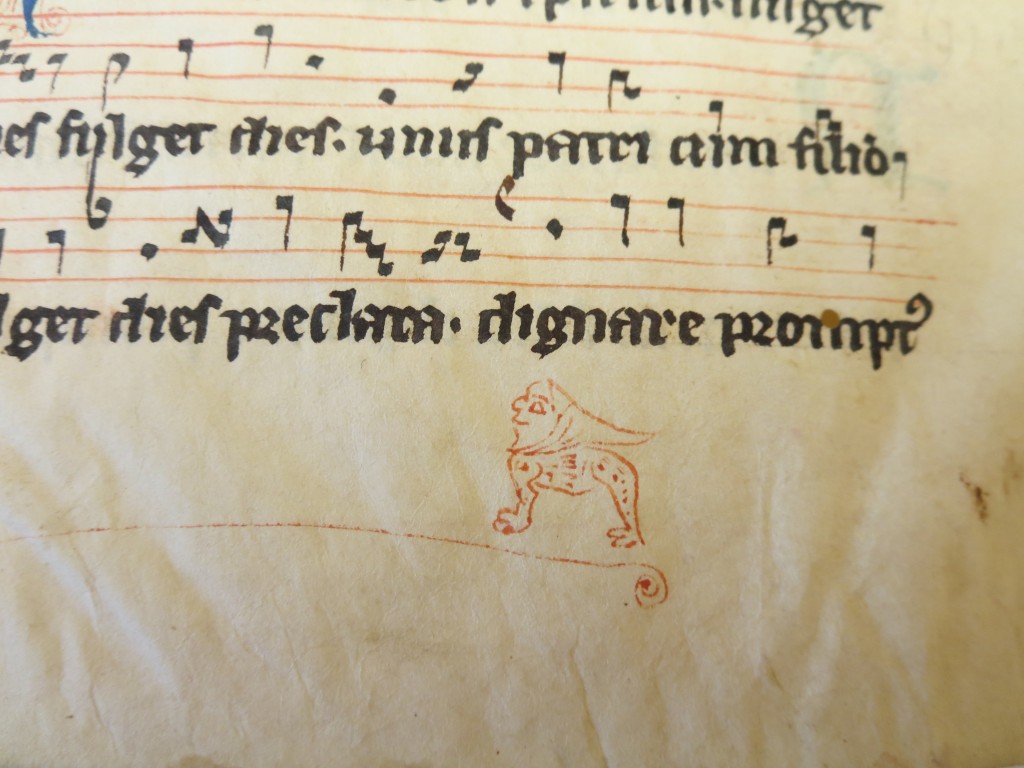
Beinecke Rare Book and Manuscript Library, Otto Ege Collection, Family Album, Specimen Leaf from ‘Ege Manuscript 8’, Recto, Detail.
[Some newly consulted materials:
- Ege Memorial Microfilm, self-described thus:
Dean Otto F. Ege: A Microfilm Memorial Arranged by His School Mates and Friends of Reading, Pa.
(Reading, PA, 1952)
available as a printout at The Morgan Library & Museum
(Reference Collection, Call No.: 139 E29, entitled thus:
Dean Otto F. Ege: A Microfilm Memorial Arranged by His Friends and School Mates) with reproductions of the front-facing pages in the full sets of Portfolios “lent by the Reading Public Museum and Art Gallery” on “October 14, 1952”.
Distribution Patterns
The leaves were distributed notably in one or another of Ege’s Portfolios or “Leaf Books” which assembled individual specimens, mounted and labeled, devoted to specific themes or genres of books. The specimens were extracted, usually as single leaves, from Western medieval manuscripts (Fifty Original Leaves) or from a few medieval manuscripts and many printed books (Famous Bibles and Famous Books).
Other methods of distribution pertained, mainly from the left-overs — whether mounted and labeled, or not. Sometimes the single leaves retain only the mounting tapes which attest to a former mounting, and to an intention at one time to distribute thus — an intention however revoked, as the leaf was removed from its mat for a different destination or distribution. (Such cases are demonstrated below, in some leaves which returned to places within the Ege Family collection, now at the Beinecke Library.)
The value of paying attention to which Portfolio, which Edition of said Portfolio, and which Set within which Edition of which Portfolio turns out to be even more important as the research progresses.
For Real Estate, the slogan-or-mantra could be “Location, Location, Location”. For Dispersed Manuscript Studies, it could be “Details, Details, Details”.
Some of the benefits of such attention appear in the updates for the individual manuscripts. For example, it turns out to be useful to distinguish which Edition of which Portfolio to which an online library catalogue or description really refers, even when it garbles some of the identification, partly — it appears — from assumptions about the correspondence (or, rather, not, or not exactly) with an existing entry from another library’s or collective’s storehouse.
Some listings within the WorldCat groupings for the Famous Books in Nine Centuries (issued in 50 numbered sets) really pertain to the version in Eight Centuries (issued in 110 sets), as shown — if the details might be provided through further online research into the institution’s own catalogue — by the indication of the set number as being X out “of 110”. Likewise, it is possible to discern, with some checking, even when such details are lacking, that the five medieval manuscript leaves at the Mayo Clinic must come from, or still reside within, one of Ege’s sets of Famous Books in Nine Centuries, because the quoted descriptions correspond with Ege’s labels for them, and, moreover, because the description for the Aristotle Leaf (= Ege Manuscript 51) states that it was written by “a secular scribe”, as in that Edition, rather than by “a secular monk”, as in the Eight Centuries Edition.
Subtle but significant. As they say (or as we might), “The Devil Is In The Wrong Details”. Another blogpost will tell about the WorldCat mixup, concerning its conflated and confusing presentation of the individual representations of a varied and variable Portfolio assembled by Otto Ege and preserved in various collections. See here and here.
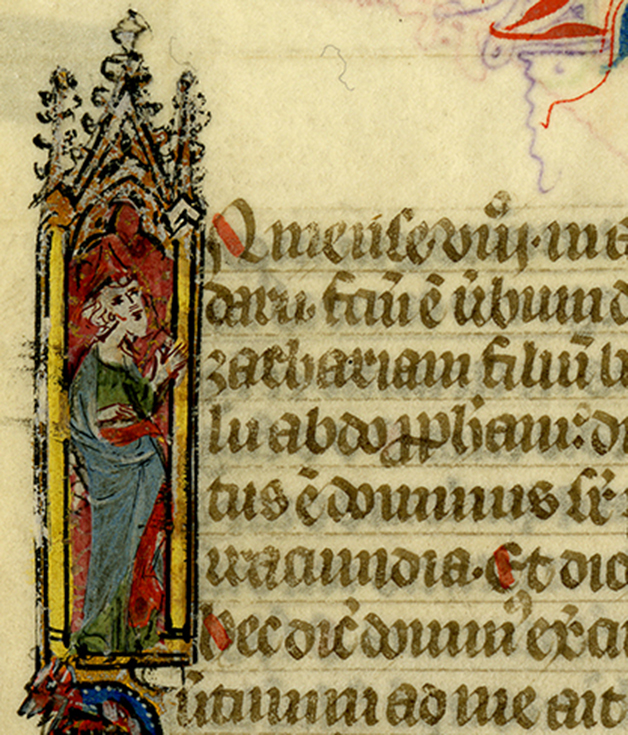
Opening Lines of the Book of Zachariah. Courtesy of Flora Lamson Hewlett Library, Graduate Theological Union, Berkeley, CA. Reproduced by permission.
*****
Significant evidence emerges through inspection of many bodies of evidence, especially in combination, in an integrated approach worthy of the Research Group on Manuscript Evidence. As defined in our own nonprofit Mission and exemplified in our myriad activities over the years.
For the purposes of the various Ege manuscripts, these co-ordinated and integrated research activities approach a variety of evidence:
- Individual sets of the Portfolios, of “Rogue Leaves” (defined in our earlier Manuscript Studies blogposts)
- “Residue” Materials (ditto) — in the forms of parts of Quires (paired bifolia and more, nested, sets of bifolia, rather than single leaves alone) and a Binding — in the new Otto Ege Collection at Yale University, and in collections at other Ivy League Universities, and at The Morgan Library, as well as through photographs in other collection
- Other materials, including individual leaves which may emerge in whatever locations, online selling points included.
*****
Watch this space. We continue to pursue the quest. Do you have questions or suggestions? Do you know about manuscript materials you would like to show and tell? Please let us know! Contact Us or add your Comments here.
*****
Update on 18 June 2020: See
- A Leaf from ‘Otto Ege Manuscript 19’ and Ege’s Workshop Practices
- Some Leaves in Set 1 of Ege’s FOL Portfolio — including from ‘Ege Manuscripts 8, 14, 19, and 41’.
*****

